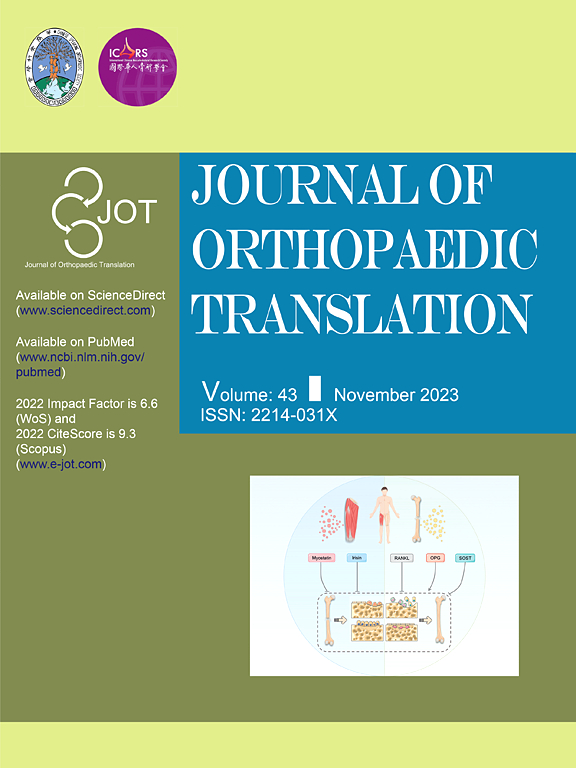电流在椎间盘健康中的作用:离子通道在椎间盘病理生理中的作用
IF 5.9
1区 医学
Q1 ORTHOPEDICS
引用次数: 0
摘要
椎间盘退变(IVDD)是全球普遍关注的健康问题,是导致颈部和背部疼痛的重要因素。椎间盘是由髓核、纤维环和软骨终板组成的无血管结构,对调节脊柱运动、承受应力和缓冲振动至关重要。由于其特殊的解剖结构和功能作用,极易受到外界因素的刺激。离子通道是一种跨膜蛋白,在心血管疾病和神经系统疾病中引起了极大的关注并取得了很大进展,其在IVDD病理生理中的重要性正逐渐得到认识。它们作为受体刺激钙在细胞内的内流,作为第二信使激活下游通路,上调转录蛋白的表达,从而引发IVDD。本文根据离子通道的主要激活机制,将离子通道家族分为三类,并阐述了离子通道从转录、翻译到转运和表达的调控。因此,离子通道在IVDD病理生理中的作用及其在治疗中的潜力和实用性是本综述的主要主题。我们希望这篇综述可以帮助理解和开发新的、特异性的IVDD治疗方法。离子通道的靶向治疗策略在IVDD的治疗中尤为重要。离子通道靶向药物和离子通道的组织工程策略已经成为通过调节椎间盘细胞中的钙稳态、炎症反应和细胞外基质代谢来干预IVDD的新治疗靶点。此外,随着纳米技术的发展,离子通道靶向治疗与先进的药物输送系统的结合代表了IVDD治疗的一个有前景的前沿。基于纳米颗粒的载体和水凝胶介导的缓释平台已成为增强药物生物利用度和在无血管、机械应力椎间盘微环境中时空控制的互补策略。此外,系统探索结合离子通道靶向药物与抗炎药、生长因子等补充药物的联合治疗方法,是提高IVDD治疗效果的必要研究。本文章由计算机程序翻译,如有差异,请以英文原文为准。

Electric currents in disc health: The role of ion channels in intervertebral disc pathophysiology
Intervertebral disc degeneration (IVDD), which is known as a common global health concern, has been a significant factor in neck and back pain. The intervertebral discs are avascular structures consisting of the nucleus pulposus, annulus fibrosus, and cartilage endplate, which are crucial for regulating the spinal motion, withstanding stress, and buffering vibration. Due to their special anatomical structure and functional role, they are highly susceptible to stimulation by external factors. Ion channels are transmembrane proteins which have attracted significant attention and great progress in cardiovascular diseases and neurological diseases, and the importance of them in the pathophysiology of IVDD is gaining recognition. They function as a receptor to stimulate the influx of calcium within cells, which acts as a second messenger to activate downstream pathways and upregulate the expression of transcriptional protein, thereby triggering IVDD. This review classified the ion channel families into three types based on their primary activation mechanisms, and then described the regulation of ion channels from transcription and translation to trafficking and expression. Subsequently, the function of ion channels in the pathophysiology of IVDD as well as their potential and practicality in treatment were the main topics of this review. We hope this review could help understand and develop new, specific therapies for IVDD.
The translational potential of this article
Targeted therapeutic strategies for ion channels are particularly critical in the treatment of IVDD. Ion channel-targeted drugs and tissue engineering strategies for ion channels have emerged as novel therapeutic targets for intervening in IVDD by modulating calcium homeostasis, inflammatory responses, and extracellular matrix metabolism in disc cells. In addition, as the development of nanotechnology, the integration of ion channel-targeted therapies with advanced drug delivery systems represents a promising frontier in the treatment of IVDD. Nanoparticle-based carriers and hydrogel-mediated sustained-release platforms have emerged as complementary strategies to enhance drug bioavailability and spatiotemporal control within the avascular, mechanically stressed intervertebral disc microenvironment. Furthermore, systematic exploration of combination therapies integrating ion channel-targeted drugs with complementary pharmacological agents like anti-inflammatory drugs and growth factors warrants rigorous investigation to enhance therapeutic efficacy in IVDD management.
求助全文
通过发布文献求助,成功后即可免费获取论文全文。
去求助
来源期刊

Journal of Orthopaedic Translation
Medicine-Orthopedics and Sports Medicine
CiteScore
11.80
自引率
13.60%
发文量
91
审稿时长
29 days
期刊介绍:
The Journal of Orthopaedic Translation (JOT) is the official peer-reviewed, open access journal of the Chinese Speaking Orthopaedic Society (CSOS) and the International Chinese Musculoskeletal Research Society (ICMRS). It is published quarterly, in January, April, July and October, by Elsevier.
 求助内容:
求助内容: 应助结果提醒方式:
应助结果提醒方式:


